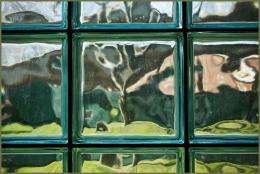Materials scientists find better model for glass creation

(PhysOrg.com) -- Harvard materials scientists have come up with what they believe is a new way to model the formation of glasses, a type of amorphous solid that includes common window glass.
Glasses form through the process of vitrification, in which a glass-forming liquid cools and slowly becomes a solid whose molecules, though they've stopped moving, are not permanently locked into a crystal structure. Instead, they're more like a liquid that has merely stopped flowing, though they can continue to move over long stretches of time.
"A glass is permanent, but only over a certain time scale. It's a liquid that just stopped moving, stopped flowing," said David Weitz, Mallinckrodt Professor of Physics and Applied Physics at Harvard's School of Engineering and Applied Sciences (SEAS) and the Department of Physics. "A crystal has a very unique structure, a very ordered structure that repeats itself over and over. A glass never repeats itself. It wants to be a crystal but something is preventing it from being a crystal."
Other than window glass, made from silica or silicon dioxide, Weitz said many sugars are glasses. Honey, for example, is not a glass at room temperature, but as it cools down and solidifies, it becomes a glass.
Scientists like Weitz use models to understand the properties of glasses. Weitz and members of his research group, together with colleagues at Columbia University and the University of North Texas, report in this week's Nature a new wrinkle on an old model that seems to improve how well it mimics the behavior of glass.
The model is a colloidial fluid, a liquid with tiny particles, or colloids, suspended evenly in it. Milk, for example, is a familiar colloidial fluid. Scientists model solidifying glasses using colloids by adding more particles to the fluid. This increases the particles' concentration, making the fluid thicker, and making it flow more slowly. The advantage of this approach to studying glasses directly is size, Weitz said. The colloid particles are 1,000 times bigger than a molecule of a glass and can be observed with a microscope.
"They're big; they're slow. They get slower and slower and slower and slower," Weitz said. "They don't behave like a fluid. They don't behave like a crystal. They behave in many ways like a glass."
The problem with traditional colloids used in these models, however, is that they often rapidly solidify past a certain point, unlike most glasses, which continue to flow ever more slowly as they gradually solidify. Weitz and colleagues created a colloid that behaves more like a glass in that way by using soft, compressible particles in the colloid instead of hard ones. This makes the particles squeeze together as more particles are added, making them flow more slowly, but delaying the point at which it solidifies, giving it a more glasslike behavior.
By varying the colloidal particles' stiffness, researchers can vary the colloidal behavior and improve the model's faithfulness to various glasses.
"There's this wealth of behavior in molecular glass and we never saw this wealth of behavior in colloid particles," Weitz said. "The fact you can visualize things gives you tremendous insight you can't get with molecular glass."
Source: Harvard University (news : web)

















